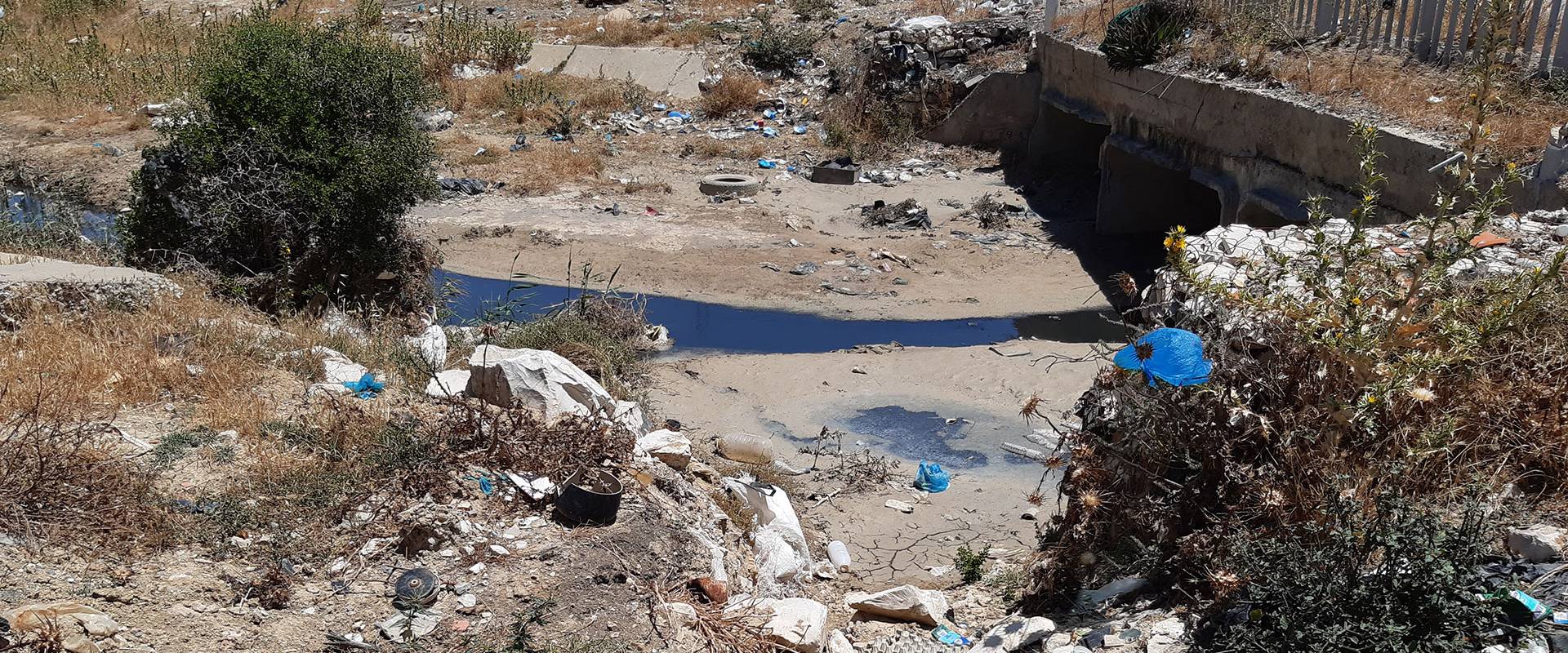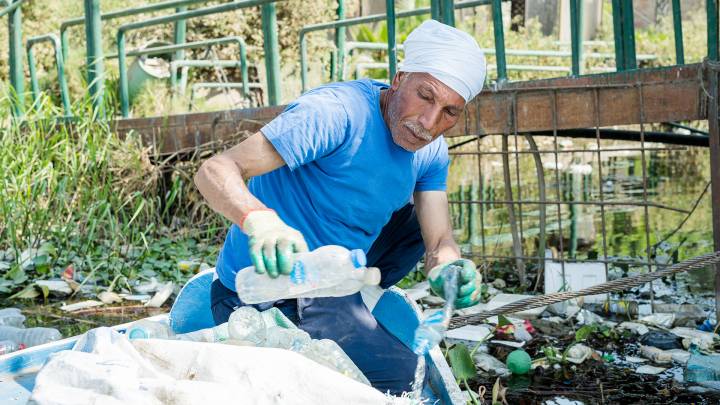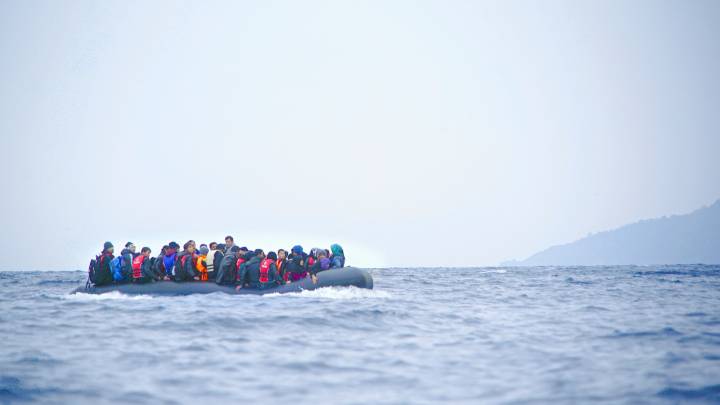The Maghreb’s most important river is being polluted by 30,000 industrial plants. While government bodies and factory owners appear unable and sometimes unwilling to help keep the Medjerda clean, residents and farmers suffer the dire consequences.
The glow of Tunisia’s spirit, the Medjerda river, has quietly crept into Ameur Horchani, a water expert and former Secretary of State for Water Resources for 17 years. For sixty years he has followed the river’s path and development, and when he speaks of it today, his memories imbue him with life and passion once more.
Horchani‘s voice fills with anger as he refuses to lament the Medjerda, whose fresh waters endow Tunis with life and now threaten to take it away under the heavy weight of pollution pouring from industrial zones, urban settlements and the very treatment plants set up to protect it.
Tormented, he exclaims: “What is happening amounts to a crime to be punished with nothing less than prison!” As Secretary of State, he “saw nothing else but imprisonment as the appropriate punishment for those who pollute and deny future generations their right to clean, drinkable water”.
The Medjerda, Tunisia and Algeria‘s source of life, is slowly transforming into a swamp contaminated with sewage, industrial pollutants, waste and life-threatening toxins that all violate Tunisian environmental standards. As devastating as this situation has become in recent years, affecting agriculture, humans and animals, ground and surface water, just as remarkable is the indifference or inaction of polluters and authorities.
On 20 February, 2020, the wastewater treatment plant in Béja was gripped by complete paralysis, which led to the direct discharge of untreated wastewater into the Béja river, one of the most important tributaries of the Medjerda. The reason was the influx of industrial water, including from the Al-Baraka oil factory in El-Maâgoula, “exceeding the plant’s capacity by one thousand percent”, as the Regional Director of the National Sanitation Office (ONAS) in Béja, Fathi el-Jabali, reported to the Committee for Disaster Response.
It was not the first time a treatment plant had suffered from over-capacity, which was in fact a regular occurrence in most plants in the Medjerda basin.
Grave threat to the most important river of the Maghreb
A 2018 Study of the Medjerda River Drainage Basin by the Ministry of Environment (MoE) provides an in-depth analysis of the economic activities and sources of pollution along the river and their various real and potential effects, 202 heavily polluting industrial units besiege the river’s tributaries. The pollution caused by these industrial sites is ten to one hundred times that of urban wastewater; 75 percent of the polluting industrial units are located around water resources and 11 percent are in their proximity.
Observers consider this a grave threat to the most important river of the Maghreb. The Medjerda is the only Tunisian river that never dries out and it provides the country with half of its fresh water, transporting water from Souk Ahras, its source in north-eastern Algeria, through 484km of land, 350km of which is in the Tunisian north, and eventually to the Mediterranean Sea. Its basin extends over an area of 23,500 square kilometres, 7,600 of it in Algeria.
Cutting through mountains, plains and plateaus, the Medjerda is supplied by numerous tributaries that join its left and right banks and its basins in Tunisia and Algeria, including the Mellègue river, Tessa river, and Sidi Salem lake and dam. Over the course of history, life, business and industry have evolved around the Medjerda, which Ameur Horchani calls the “soul and lifeline of Tunisia”. It has always been a focal point of water and agricultural strategy.
Today, more than three million people live next to the river. Vast industrial and residential developments have imposed various new challenges, the likes of which were not encountered by the very first team of engineers that the Tunisian state tasked with managing the Medjerda back in the 1960s. Horchani was on this team and remembers that the greatest challenge back then was Triassic sandstone, which has a high level of salinity. “Managing the Medjerda river’s water and dealing with its pollution and problems have the same importance.”
“A crime against the children of Tunisia”
The pollutants concentrated in urban and industrial wastewater spilling into the Medjerda basins are estimated at 60,000 tons per year, with roughly one third attributed to urban areas and two thirds to industrial units. Factories have been openly as well as secretly discharging production waste and toxins into the main river and its tributaries for years, a practice that Ameur Horchani insists is a “crime against the Medjerda and the children of Tunisia”.
Many of the industrial units next to the river are part of the food industry and they eject contaminated waters into the lower and upper basins of the Medjerda and its tributaries. A laboratory analysis of samples from the factory discharges in the lower basin of the Medjerda – conducted by a team from the School of Engineers in Medjez el-Bab that included Professor Fatima el-Trabelsi – confirmed the presence of zinc, cadmium, lead, chromium and manganese. A severe violation of both Tunisian standards and guidelines set by the World Health Organisation.
El-Trabelsi expresses concerns that the concentration of these elements has had a dramatic impact on plants, land and water resources. She explains that the density of waste released by tomato processing factories carries organic matter into the water and acts like a “bacterial machine”.
The professor further warns of the effects of surface water pollution on groundwater and the possibility of toxic agents leaking into it. This constitutes a clear violation of Tunisian law. The 2014 annual report of the Tunisian Observatory for the Environment and Sustainable Development confirms that the discharge of industrial water into the natural environment was the cause of the deterioration of water quality and its pollution.
Some of the polluting factories ignore even existing capabilities that could help lower the toxic output. The Durra canned foods factory in Testour, which discharges huge quantities of wastewater directly into the Siliana river, has an unused primary treatment plant, according to findings by the investigators in July 2020, the peak production period. Challenged on this matter, factory owner Ali el-Mabrouk explained with indifference that his factory “is not active in the chemical sector but only processes fruits that do not contain toxic or harmful substances”.
He claimed that the water that the factory discharged was cleaner than the water in the river itself, insisting that the primary treatment plant was operating. However, upon observation, the plant was completely dried up and an employee confirmed that it had not been used during the entire time he had worked there.
The Souani cheese factory in Borj Toumi in Manouba governorate releases oil and cheese waste which blackens surrounding water resources and gives off foul smells that disturb the sleep of local inhabitants and cause respiratory problems. Nevertheless, its owner told National Agency for Environmental Protection (ANPE) inspectors that he was carrying out primary treatment. Here, the investigators found the treatment plant broken. Following various analyses by both the ANPE and the ONAS, the Agency also conceded that the primary treatment plants, whose tasks include removing oils, grease and toxic and harmful substances, had not been used.
Shocking scenes of plankton-choked water and animal carcasses
Water samples taken from the river next to these and other factories show sometimes gross amounts of pollution. While important, these analyses are limited and do not include all factors reflecting the extent of the pollution and the threat it poses to the environment and health. Hydraulic expert Shakib Bin Shakra stresses that the health authorities are limiting their epidemiological monitoring of the Medjerda river to germs that cause diseases, mainly typhoid fever and cholera. He predicts that increasing pollution in coming years will lead to investigations whether the water conforms with bacteriological standards and with regard to its physical and chemical properties.
To this day, there has been no comprehensive field study to prove the link between the pollution of the Medjerda river and human diseases, according to researcher Fatima el-Trabelsi from the School of Engineers in Medjez el-Bab. She explains that it is scientifically proven that industrial pollution, the use of pesticides of unknown source and chemical composition in agriculture, and the concentration of chromium, zinc, phosphorous and manganese in water cause cancerous diseases. Contaminated water can also contribute to the wear of teeth, and the presence of nitrates causes acrocyanosis and dystocia.
Water infiltrates the stomachs of human beings not only through vegetables and crops, especially through the large-scale cultivation of artichokes, tomatoes and other seasonal vegetables. It also reaches them through cattle, when the nomadic shepherds along the river bordering the grain estates seek fertile pastures. According to the Farmers Union in Manouba, miscarriage rates have increased among those animals, due to the consumption of contaminated water.
In July 2020, on the Makhschabeya Bridge across the Béja river, a tributary on the left bank of the Medjerda, the investigators stood and observed shocking scenes of plankton-choked water and animal carcasses impeding turtles and other reptiles. Hydraulic expert Shakib Shakra considered this “the clearest evidence for the severity of its pollution”.
The Béja river flows through the districts of Béja North, South and Amdoun, starting at its northern mouth, crossing through the Mateur fork where it meets the Bessim river, which flows close by industrial plants producing sugar and yeast, and continues to the Hajar Omar area, where the treatment station is located, crossing El-Maâgoula and Makhschabeya Road, after which it reaches Lake Sidi Salem and ultimately the Medjerda river.
Along this course, a Public Water Domain Commission monitoring mission on 20 February, 2020 found a “catastrophic situation”, especially around Hajar Omar, where the river “emits repugnant odours and the waters around El-Maâgoula, El-Makhschabeya and the bridge across Béja river take on a black and dirty colour”.
A threat to health and safety
A Commissariat for Agriculture report warns that the constant stagnation of water in the proximity of residential neighbourhoods poses a threat to the health and safety of citizens, especially given the direct flow of the Béja river into the Sidi Salem dam, which is used for drinking water, agricultural irrigation and husbandry. Béja river water is also potentially exploited to irrigate El-Muqawla and Al-Khashbah, where farmers may obtain licences to do so in light of an acute shortage of rain.
Subsequently, a charter for the Bessim river was concluded and a short-, medium- and long-term action plan was proposed to remove sewage, industrial wastewater and solid waste, to reduce the excessive use of pesticides, to decontaminate the industrial zone, to erect a physical, chemical and biological treatment plant for sugar and yeast manufacturers, to develop spaces for the Béja slaughterhouse, and to control the disposal of pomace and mill waste.
The regional authorities estimated the cost of implementing all elements of the plan would amount to about five million dinars. One of its main goals was to save the subterranean water resources of the Bessim river from the threat of industrial discharges. Since these resources are exploited by the National Company for the Distribution of Drinking Water due to their quality, they are among the most significant water resources in the country.
But the charter was never implemented, and the environmental situation remained catastrophic based on what the investigators could see and smell along the Bessim river: industrial discharges and slaughterhouse waste accompanied by repulsive smells, in particular from the yeast factory, the subject of complaints by local inhabitants in August 2020.
The situation was no different on the other side of the Medjerda river, where repulsive smells and toxic gases from the water collection basins of the yeast plant in Jendouba North pervaded the air. As these waters have repeatedly infiltrated fields and rivers of the surrounding area, leading to the death of cattle, the residents of the village Bin Bashir, close to the Medjerda river, staged a protest.
Every day, a total of 19 treatment plants, meant to filter wastewater from sludge, sediments and organic pollutants, pour 31,500 cubic meters of wastewater into the Medjerda river and its tributaries. Twelve treatment stations eject their water directly into the main river, six into the upper basin and six into the lower basin, while seven other stations discharge into tributaries. An assessment of whether treatment plants operate in compliance with national standards really does not require analyses or tests. The poor quality of effluents, which are discoloured and smell badly, from most of the aforementioned treatment plants is perceivable with eyes and nose and has come to the acute attention of local inhabitants.
Following the analysis of water samples in the aforementioned MoE study from different treatment plants, the effluents of six plants do not meet the standards for chemical oxygen demand. Moreover, four treatment plants did not comply with the Tunisian standards for biochemical oxygen demand, and only eight out of eleven plants were compliant with the norms for biological properties. Seven treatment plants violated the standards for bio-oxygen absorption and suspended solids, the most important indicators of the degree of pollution.
A flaw in the system
The Ministry of Agriculture has already espoused its standpoint by acknowledging the non-compliance of treated water with Tunisian standards, after having conducted studies and monitoring surveys on the water quality in recent years, as confirmed by Akissa Bahri, former Secretary of State for Water Resources and current Minister of Agriculture, Hydraulic Resources, and Maritime Fisheries. In a meeting she pointed out that reused treated wastewater in Tunisia had decreased to 30 percent, and areas irrigated with treated water had been reduced from 8,000 hectares to only about 2,000 hectares.
Several civil society activists, as well as some treatment plant representatives who wish to stay anonymous, agree that the greatest flaw in the system lies in the completion of concession contracts for treatment plants with parties that lack serious interest in operating the plants and whose behaviour and actions do not meet the required standards and imposed conditions. This comes in addition to a lack of supervision, which allows for misconduct and violations without any consequences.
Over the years, complaints and petitions have multiplied and turned into protests and road blockages. The authorities responsible for agriculture, health, sanitation and the environment have drained important funds for costly laboratory analyses, without getting anywhere near a solution. Evidence for that, in the shape of official documents and correspondence going back five years and obtained by the investigators, is aplenty.
Throughout 2018, ANPE officials issued 44 reports on industrial plants in the governorates of Manouba, Béja, Jendouba and Siliana, according to its Department for Environmental Monitoring. However, one of their experts, who wishes to remain anonymous, says it could take up to three years for a report to be handed over to the judiciary, giving violators years of free reign to commit the same mistakes and crimes. He points out that factories do not carry out primary treatment, even if they have an adequate plant to do so, since it could cost large companies millions of dinars. He admits that implemented solutions like the Industrial Depollution Fund have so far only been partly successful.
He admits in a low voice that most violators know the extent and consequences of penalties and deliberately refrain from installing or operating primary treatment plants, because it is a “profitable equation” for them. He suggests that the state should intervene and build collective treatment plants in industrial areas, partly financed by the industrial companies, as is the case in Italy, for instance.
Most monitoring mechanisms put in place fail to protect water resources from pollution or deter violations. However, according to Tunisian law, ANPE bears the main responsibility for monitoring pollution sources and environmental damage in all shapes and forms.
The director of ANPE’s Department for Environmental Monitoring, Mona El Safaqsi, confirms the important role of her agency and the great responsibility placed on its shoulders, with material and human resources sparse and the law paralysed, especially when it comes to issuing penalties. The number of authorised observers at the Agency has never exceeded 35 across all governorates, while the Medjerda basin area alone has 30,000 industrial plants, most in the leather and textile industries.
The research for this article was supported by the Candid Foundation’s journalism grant.



